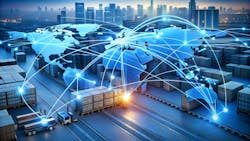Supply Chain Management Is Overdue for an Upgrade
Managing supply chains requires understanding much more than just logistics, transportation costs and time and supplier management.
Thanks to satellite-enabled transparency and connectivity, ubiquitous internet and data and the world of online information, we live in a time when everything seems so close. On the flip side, geopolitical instability results in energy cost imbalances between regions. Current and future conflicts, and the implications of climate change, are combining to make the world divided, with gaps widening rather than closing.
Global and regional disruptions have impacted supply chains repeatedly in the past year, mostly through transportation and supplier cost increases and transportation and delivery delays. Supply chain organizations can expect global or regional disruptions to continue for at least the next 12 months.
The complexity of overcoming such challenges is only expected to increase. This is especially true for issues related to data and intellectual property security, manufacturing footprints and control of safe cargo routes.
Efficient and resilient supply chain operations require effective implementation in several key areas.
Transparency
Absolute visibility of orders and related data is essential. Dedicated cargo tracking and logistics software can be integrated with the supply chain control tower to have a single-point overview of orders and shipments.
Tracking solutions are typically cloud-based to provide real-time or near-real-time information about the location of the shipment as well as the humidity, temperature, shock, and light it is exposed to. Battery life and infrastructure costs must also be factored in.
The ubiquity of data requires enhancing trust and transparency across the entire supply chain. Blockchain technology can reduce fraud by providing immutable tracking of goods.
Factory capacity, quality issues, and inventory are among the most critical information that supply chain teams work with to mitigate bottlenecks and tame costs. A scalable and secure infrastructure contexualizes and integrates data from a variety of sources, to achieve transparency across operations.
Cargo Safety
Ensuring on-time, in-full delivery requires a focus on cargo safety. This includes:
- Cargo tracking: GPS and RFID technologies monitor cargo location and condition in real time.
- Security protocols: Implement stringent measures to prevent theft, tampering, and loss .These can include technology such as RFID and GPS Tracking, video surveillance and monitoring, secure document management, etc.
- Incident management: Develop plans to address and mitigate lost or compromised cargo. These plans typically include real-time incident reporting, cargo recovery and containment plans, loss mitigation and contingency plans, to name a few.
Water, Weather, and Geopolitics
Monitoring geopolitical developments and using AI-powered models can help track risks from weather impacts, water scarcity and geopolitical control over resources. A Nature study highlighted heat stress effects on supply chains, particularly in crop farming, construction and mining. Light manufacturing — including metal products, rubber and plastic products, food processing, beverages, and tobacco — is vulnerable to indirect effects due to shortages of raw materials (e.g., minerals, metals, crops, oil, seeds and vegetables).
Power/Energy
National energy policies and the availability of key raw materials — including gas, liquefied petroleum gas, and oil — impact the cost of transport and the footprint of manufacturing and cargo hubs. Planners must assess the reliability of the power supply for manufacturing and logistics operations.
Green energy sources like hydrogen, solar and wind and national sustainable energy strategies play a role, especially in the sourcing of green products. Supply chain managers and sustainability auditors must understand the impact of such energy sources on the price and compliance of the shipped goods.
Cybersecurity
Cyberattacks pose significant risks. A 2023 World Economic Forum study revealed that 93% of cybersecurity professionals and 86% of business leaders believe a catastrophic cyberattack is possible within two years. Geopolitical instability was cited as a potential key factor in such an attack.
Recommendations include:
- Data protection: Implement robust measures to protect sensitive data. Leverage end-to-end encryption, including public key infrastructure, access control and user authentication, secure file transfer protocols, data integrity monitoring, etc.
- Access control: Use strict mechanisms to ensure only authorized access. Leverage role-based access control, multi-factor authentication, attribute-based access control, etc.
- Incident Response: Develop a comprehensive incident response plan to quickly address and mitigate the impact of cybersecurity incidents.
Regulatory Requirements
Regulatory compliance poses a continual challenge. Regulations on hazardous materials, restricted and dangerous goods handling, and customs requirements undergo frequent updates and are strictly enforced.
To ensure compliance, it is recommended that supply chain stakeholders stay informed about the latest regulations, invest in comprehensive employee training programs, maintain accurate records, and implement robust quality control processes.
Staying informed about, and complying with, regulations related to carbon management — such as the Carbon Border Adjustment Mechanism (CBAM) and the Corporate Sustainability Reporting Directive (CSRD) — is crucial. Supply chain organizations also need to focus on initiatives to reduce their carbon footprint (scopes 1, 2, and 3 emissions) and improve sustainability across the supply chain.
Tariffs and Taxes
Understanding the tariffs and tax environment is crucial for both finance and the supply chain team. Trade tensions between China and the U.S. and China and the European Union, for example, have recently resulted in several actions and counteractions.
In May, the Biden administration announced significant tariff increases on China, targeting roughly $18 billion in strategic industries. These tariffs, which quadruple to 100% on Chinese EVs, are designed to counter China’s trade practices and overcapacity while boosting U.S. industries, according to Forbes.
Semiconductors, batteries, battery packs, some steel and aluminum products, various minerals and ores including manganese and cobalt, and radioactive substances are among the items set to face increased import costs.
Bottom Line
Supply chain orchestration is becoming an increasingly multi-criteria exercise due to the rising complexity of causal relationships and the occurrence of black-swan events. The winners of the global supply chain challenge will be organizations that can turn the absolute transparency of data, costs, inventories and cash management into a flexible and resilient operating model.
Organizations need to overcome several issues on this ongoing path. Along with workforce and operational assets, digital technology is a cornerstone of success. An IDC survey revealed that some organizations’ IT systems are dominated by legacy/on-premises applications that are neither flexible nor scalable.
Planning has always been a crucial discipline in any supply chain-driven organization. A zeal for efficiency has led to improvements in supply chain planning tools, seamless integration of supply chain applications, flexible and adaptable logistics solutions/contracts, and supply chain diversification. Some organizations have focused on costs at the expense of resiliency — but the global priority should be improving supply chain resiliency, including visibility and agility.
The current cocktail of global geopolitical tensions and interconnected trade has turned the supply chain into a political weapon. Organizations must be ready to integrate the workforce, technology, and intelligence into one balanced, continuously learning, and adapting organism — regardless of which way the political winds blow.
About the Author

Jan Burian
Global Analyst
Jan Burian is a global analyst, author, and speaker. His expertise spans digital transformation, management, leadership, and the geopolitical influences shaping manufacturing and global supply chains. Jan led Manufacturing Insights Europe at IDC and held consulting positions at EY and Deloitte.
